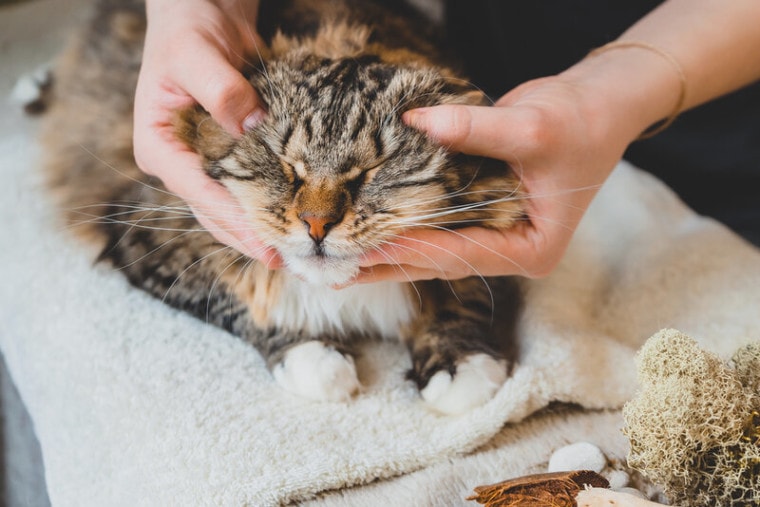
Click to Skip Ahead
Humans enjoy getting massages, so why wouldn’t cats?
As our understanding of cats increases, we are becoming more aware of their experiences with pain. When our cats suffer acute or chronic pain, we often try to help by looking to sources that relieve our discomfort. Massage therapy is just one of the ways we have brought human techniques into the realm of feline health and well-being.
Although massages are not replacements for prescription drugs, surgeries, or other critical veterinary treatments, they can be helpful supplements for managing pain. Even if your cat is not experiencing pain, massaging him can be a great way to show him love and care. It can also help him relax and unwind after a stressful event.
Whether you want to help your cat through a difficult time or you want to bond, massage therapy can be a great technique.
How Does It Work?
Cat massage therapy involves working the soft tissues in your cat’s body. The massage comprises several techniques, such as applying pressure, holding, and moving your cat’s tissues. The more specific methods are referred to as “strokes.” Each stroke has its own meaning and use.
Massage therapy is best done when your cat is in the proper mood. If your cat is agitated, skittish, or tense, he may not be receptive to a massage. In fact, touching him when he does not want to be touched can achieve the opposite effect and only stress him out more. Wait until your cat approaches you with a desire for attention and affection, then you can start a massage.
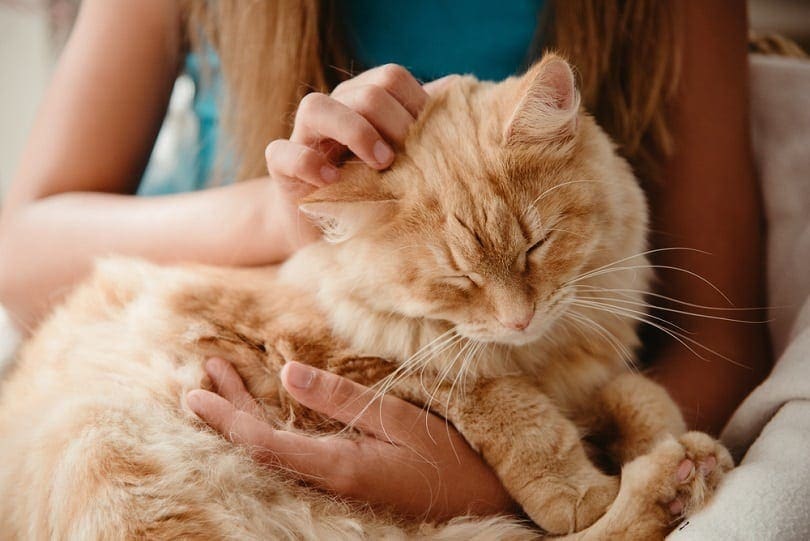
What Are the Different Types of Cat Massage Therapy?
There are many types of strokes for cat massage therapy that have various applications and purposes.
1. The Simple Stroke
The simplest form of cat massage therapy is a simple stroke. Simple stroking is very similar to petting your cat; you run your hand from one end of his body down to the other. When stroking your cat, you will place your hand on his body with low to moderate pressure. Start at the head, then gradually move throughout the body. Apply gentle pressure to his limbs as well as to his tail.
This technique is a good way to start and end a massage session since your cat is likely familiar with it. Also, the simple stroke is an excellent opportunity to check over your cat’s body. This petting will allow you to look for areas with tension, swelling, lumps, or inflammation. If your cat is experiencing any pain, the simple stroke may be able to make his pain evident.
2. The Effleurage
Another technique, the effleurage, usually follows the simple stroke. An effleurage is performed by applying moderate pressure with the entire hand, then stroking your cat in even, flowing motions. The focus areas of this technique are the lines of your cat’s muscles and the superficial tissues.
The direction of the effleurage strokes usually is towards the heart. When doing the effleurage technique on your cat, you will stroke him from his toes to his chest and then from his backside to his head. The purpose of effleurage is to promote circulation within the blood vessels and the lymph nodes. This is great for reducing any fluid-related swelling.
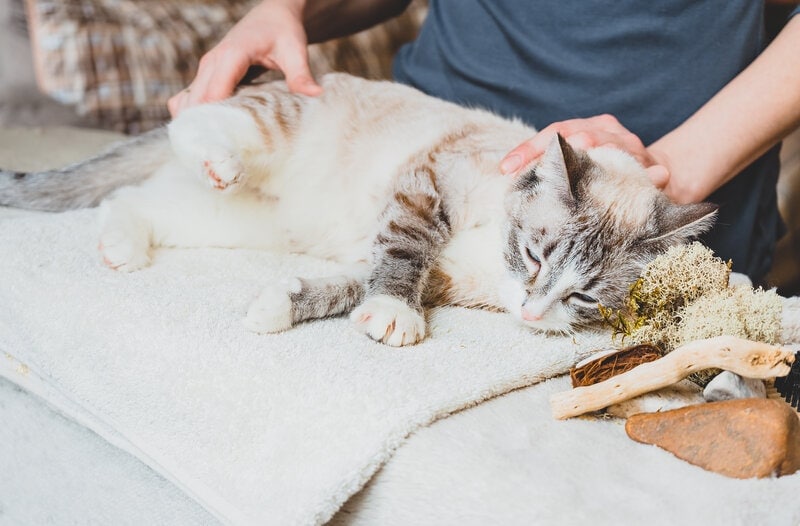
3. The Petrissage
The petrissage is the next level in a therapeutic cat massage. During the petrissage, you knead your hands into your cat’s muscles to relieve tension. This is especially helpful for undoing knots in the soft tissues and managing muscle spasms.
Skin rolling is a variation of the petrissage. When skin rolling, you start at the end of your cat’s limbs, then work your way up to the torso. If you start at your cat’s tail, you will move toward the head. This technique increases circulation in the skin and subcutaneous tissues.
4. The Concussive Stroke
Referring to a stroke as concussive may sound frighteningly aggressive, but we promise it isn’t as bad as it seems. Concussive strokes involve moderate pressure from tapping your hands against your cat’s body. The first concussive stroke is called chopping.
Chopping is when you use the edge of your hand in swift motions to apply gentle pressure over large areas of muscle. The second stroke is called tapping and is slightly more specific than chopping because it utilizes your fingers to tap specific areas.
The third concussive stroke is tapotement, which is when you cup your hand and use the edge of it to form a circular surface to place gentle pressure on your cat’s body. Concussive strokes are great for increasing circulation.
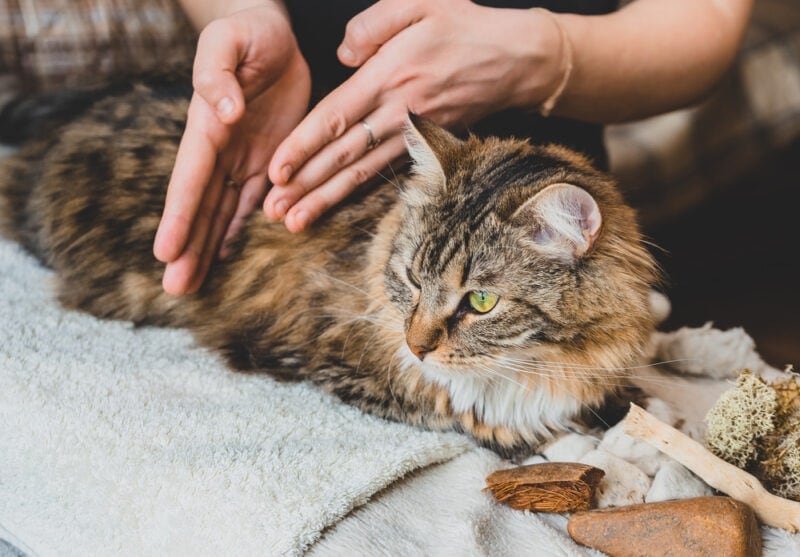
Where Is It Used?
A full-body, therapeutic cat massage is best performed by trained professionals. However, many of the basic techniques can be easily taught for use at home. Once you have practiced some of the strokes and feel confident in your abilities, you can begin giving your cat massage therapy from the comfort of your own home.
When you learn massage therapy techniques and begin to use them, you are creating an opportunity to bond with your cat. Offering your cat relief and healing through a massage is a great way to strengthen your connection. The soothing physical contact will promote trust and warmth between you and your cat.
Advantages of Cat Massage Therapy
The advantages of cat massage therapy are fairly straightforward. Much like with human massages, cat massages can offer relief. This can be relief from stress, knots in tissues, or even pain. Whether your cat needs relief from an anxious day or from chronic pain, cat massage therapy may offer a solution.
Disadvantages of Cat Massage Therapy
Cat massage therapy is not appropriate for every situation, and it should not be used as a replacement for veterinary treatment. When your cat has open wounds, broken bones, or unmedicated pain, massage therapy is more harmful than helpful.
Likewise, if your cat suffers from blot clotting, you should not massage him. Areas that are infected or have tumors need to be avoided as well.

Frequently Asked Questions (FAQ)
To provide even more information about cat massage therapy, we gathered some frequently asked questions. Hopefully, these cover the bases of any questions that might be on your mind.
How Long Should a Massage Last?
Massages should be short. The entire massage should last no more than 5–10 minutes. Cats do not need an hour-long massage, and they probably wouldn’t appreciate it anyways. Too much physical contact is liable to irritate your cat and cause him to leave more stressed than when you began the massage.
10 minutes per day is a fine amount to massage your cat, but whatever works best for you and your cat is more than enough.
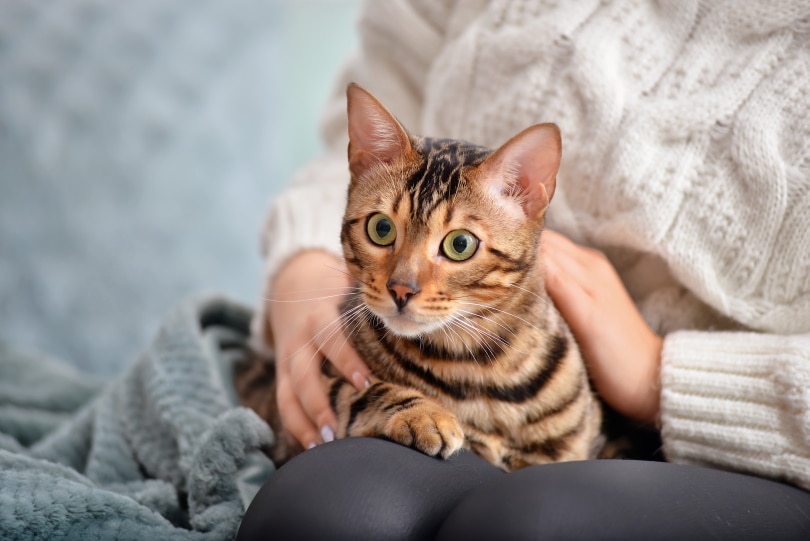
Is It Possible to Massage a Cat Too much?
Although there is no strict amount of time that you should or shouldn’t massage your cat, massaging him more than once or twice each day is excessive. One brief massage a day should suffice.
How Do You Know if You Are Doing It Right?
The best way to determine whether you are doing a good job is to pay attention to your cat’s reaction.
His tail will be the best indicator of his feelings. If his tail is gently swaying or at ease, he is happy. But if his tail seems to be twitchy or stiff, you should stop. This is a sign that he is growing irritated and may decide to show it more clearly soon.
Vocalization is also a good way to tell how you are doing. If he growls, whines, or hisses, you will need to back off. Purring, while often a sign of contentment, can also be a sign of fear. If your cat is purring, watch for other signs. If he is purring and tense, leave him alone. But if he is relaxed, then feel free to continue.
Conclusion
We are continuing to learn more about how to best support our cats, and cat massage therapy is just one of the many ways we can provide relief for them. If you think that massage therapy may be beneficial to your cat, do some research and learn how to perform the strokes. You’ll be your cat’s personal massage therapist in no time!
Featured Image Credit: Ekaterina Kuzovkova, Shutterstock







